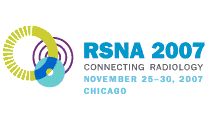
Abstract Archives of the RSNA, 2007
SSA15-09
Application of Computerized Texture Analysis of CT Lung Images for Estimation of Interstitial Lung Disease Progression
Scientific Papers
Presented on November 25, 2007
Presented as part of SSA15: Physics (Thoracic CAD )
Yulia Arzhaeva, Presenter: Nothing to Disclose
Keelin Murphy, Abstract Co-Author: Nothing to Disclose
Mathias Prokop MD, Abstract Co-Author: Medical Board, Koninklijke Philips Electronics NV
Cornelia Maria Schaefer-Prokop MD, Abstract Co-Author: Nothing to Disclose
Bram Van Ginneken PhD, Abstract Co-Author: Nothing to Disclose
To develop an automated system for quantification and assessment of interval changes in interstitial lung disease (ILD) based on amounts of certain patterns of abnormal textures on high-resolution CT (HRCT) scans.
54 pairs of baseline and follow-up multi-detector row HRCT scans of the lungs (time interval, 1 month to 2 years) of patients with histologically proven ILD were collected from clinical practice. Types of ILD included sarcoidosis (19), idiopathic interstitial pneumonias (18) and various immune and autoimmune disorders. Scan pairs were aligned using a non-rigid registration method, and three corresponding 1-mm thick axial sections in the upper, mid and lower third of the lungs were selected for assessment. In a side-by-side comparison two experienced chest radiologists in consensus classified the extent of disease at follow-up as better, slightly better, identical, slightly worse or worse. They also scored how obvious the difference was. Subtle slight changes were grouped together with identical extent of disease to define “stable” disease. The resulting labels “regression”, “stable” or “progression” derived from the consensus scores were used as reference standard and comprised 30, 107 and 25 pairs respectively. In the lung fields regions of the hyperlucency, fibrosis, ground glass, solid and focal textures were automatically identified using a dedicated texture classification algorithm. Differences in the relative amounts of each texture type were used as features to train and test a k-nearest neighbor classifier which assigned a disease progression label for each pair of HRCT sections. From 5 random divisions of pairs into training and test sets (40% and 60%) an average accuracy was computed.
The automated classifier yielded an average accuracy of 0.75 (standard deviation 0.02). 96% of misclassifications occurred between stable disease and progression or regression.
Estimation of interval changes may become possible by automatic quantification of changes in abnormal patterns.
Computerized analysis of texture patterns in chest CT may help assess and later quantify progression of ILD.
Arzhaeva, Y,
Murphy, K,
Prokop, M,
Schaefer-Prokop, C,
Van Ginneken, B,
Application of Computerized Texture Analysis of CT Lung Images for Estimation of Interstitial Lung Disease Progression. Radiological Society of North America 2007 Scientific Assembly and Annual Meeting, November 25 - November 30, 2007 ,Chicago IL.
http://archive.rsna.org/2007/5010012.html

